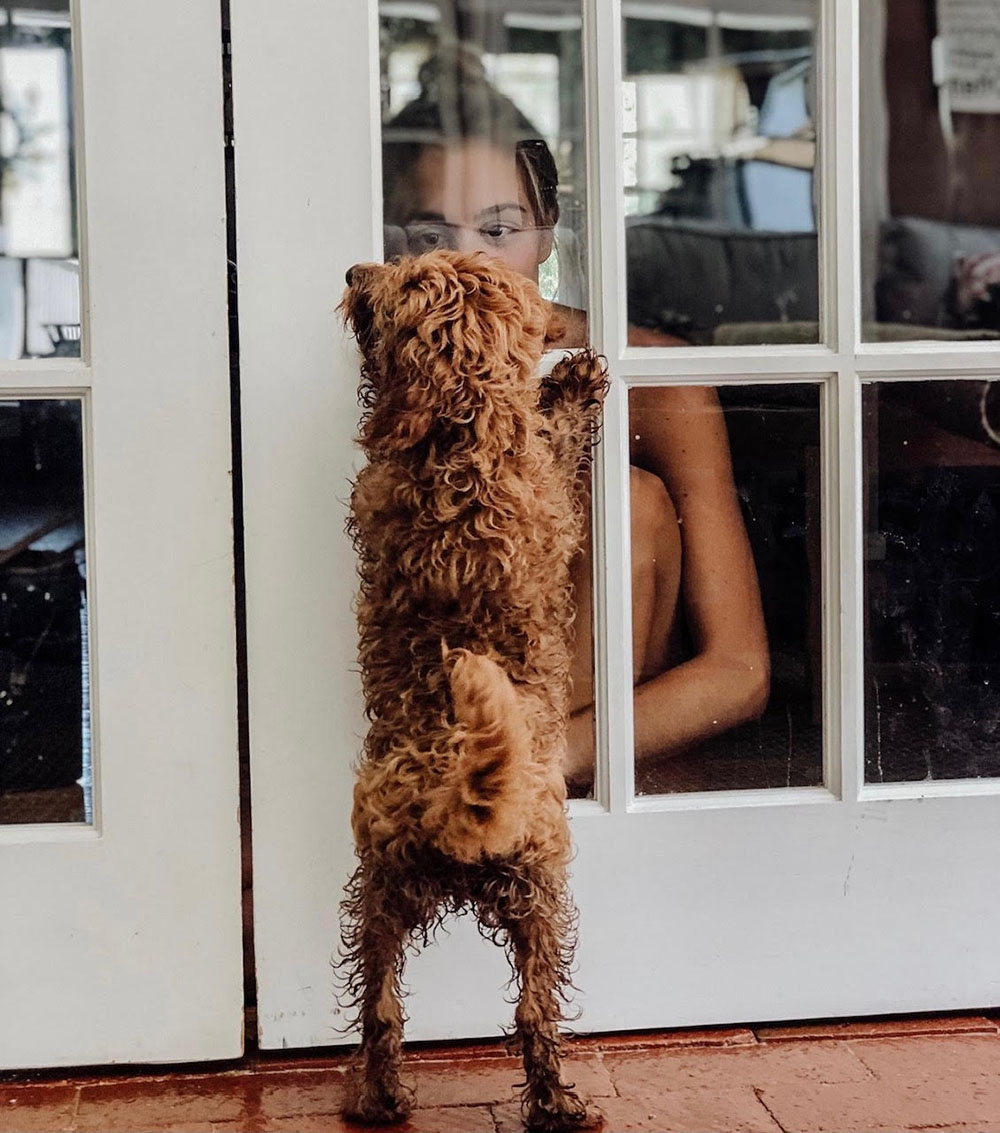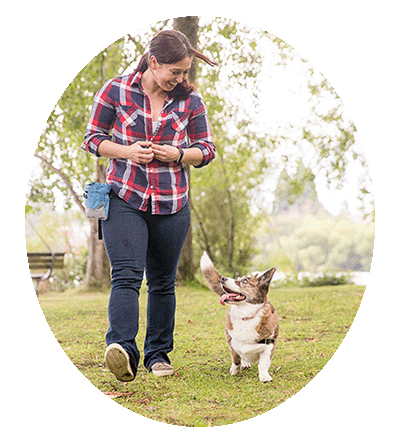Okay, we’re about to say something that might ruffle some feathers – and probably get us some strongly worded emails. But after 25 years of breeding companion dogs, we think it’s time for some honest talk about leaving dogs home alone all day. Pour yourself a coffee and hear us out.
We want to say upfront: this isn’t about judgment. It comes from our deep love for the puppies we raise and our genuine desire to see both our pups and their families truly thrive together. Sometimes the most caring thing we can do is have uncomfortable conversations.
Let’s be honest about something that many dog families wonder about: how much alone time is reasonable for our Goldendoodle and Cavapoo companions? It’s a practical question that deserves a straightforward answer, especially when you’re considering welcoming a dog into your life.
Disclaimer: This article is primarily intended for prospective dog owners in the decision-making process, rather than as commentary on established dog-family relationships.
The reality is that millions of dogs live with families who work full-time. Dogs will adjust to their family’s schedule because, well, they don’t get a say in the matter. We do. And that choice comes with the responsibility to understand what we’re truly asking of them.
You’ll often hear owners say, “Oh, they’re fine – they just sleep all day.” But here’s what’s really happening: a dog sleeping 8-10 hours during the day isn’t necessarily resting peacefully. Often, they’re simply shutting down from boredom and lack of engagement. It’s not the same as the natural, content rest that comes after mental stimulation and quality time with their family.

Understanding Your Dog’s Physical Needs
Here’s the reality: puppies need bathroom breaks every 2-3 hours, and even adult dogs shouldn’t have to “hold it” all day just because they physically can. We wouldn’t expect this level of discomfort from ourselves – most of us use the restroom multiple times daily for comfort, not desperation. When accidents happen during long alone periods, they create stress for both puppies trying to please you and families dealing with house training setbacks.
The Companionship Factor
Here’s where it gets interesting, and where different types of dogs vary significantly. Some breeds were developed to work independently – livestock guardian dogs, for example, are perfectly content spending long hours alone with their flock. Many working breeds can handle solitude without stress.
But companion breeds? That’s exactly what the name suggests – they were specifically bred to be with people. Our puppies are particularly human-focused, combining the best traits of breeds that were all developed to work closely alongside humans, reading our cues, responding to our needs, and forming deep bonds with their families.
When you bring home one of our puppies, you’re getting a dog whose strongest drive is to be part of your daily life. It’s not neediness – it’s literally what they were designed to do. They genuinely thrive on human interaction in ways that some other breeds simply don’t.
And here’s an important point: even if you arrange for someone to let your dog out for a potty break during the day, that brief visit doesn’t address the core issue of companionship. A quick bathroom break is helpful, but it doesn’t fulfill a companion dog’s deep need for social interaction, mental stimulation, and being part of a family’s daily rhythm.

The “We Deserve Dogs Too” Conversation
We absolutely understand the sentiment behind “lots of people work full-time and we deserve to have dogs too!” And yes, many working families provide loving homes for dogs. But this might be a moment for some honest reflection: are we putting our wants above a dog’s needs?
There’s an old saying that captures this beautifully: “Dogs are part of our lives, but we are their whole life.” When you leave for work, you have colleagues, tasks, challenges, and social interaction. Your dog has… your empty house.
The good news? The traditional 9-to-5 office model is rapidly changing. More people than ever work from home full-time, have hybrid schedules, or work for pet-friendly companies. Even if your current situation involves long days away from home, that might not be your reality forever. Maybe now isn’t the right time, but the future could hold more flexibility.
Real Stories, Better Timing
Over our 25 years as breeders, we’ve seen beautiful success stories unfold when families wait for the right moment. We’ve had applicants tell us, “We’ve wanted a puppy for years, but we knew it wouldn’t be fair with our old schedule. Now that I’m working from home…” or “My partner and I figured out how to work opposite shifts…” or “I finally started my own business with flexible hours…”
These families didn’t give up on their dream – they just waited until they could offer what a companion dog truly needs. And the results speak for themselves: happier dogs, happier families, and stronger bonds.

Why We Take This Approach
Here’s something we’ve learned from decades of experience: the highest rate of rehoming comes from families where dogs are left alone 8-10 hours daily, five days a week. We consistently hear heartbreaking stories: “The dog deserves a family who has more time” or “We didn’t realize how destructive they’d become” or “The constant barking complaints from neighbors…”
Bored, lonely dogs don’t just sleep peacefully. They often develop behavioral issues – destructive chewing, excessive barking, separation anxiety, or depression. These aren’t character flaws; they’re predictable responses to unmet social needs.
Better Timing, Better Outcomes
As ethical breeders, we see ourselves as advocates for both our puppies and the families who love them. When we suggest waiting, we’re not crushing dreams – we’re protecting them. We want your future relationship with your dog to be everything you’ve imagined, not a source of stress and disappointment.
We know this approach sometimes brings criticism from disappointed applicants. But after 25 years of following up with families, we’ve seen the patterns. Dogs left alone for extended periods regularly are just surviving, not thriving. And their families end up struggling too.
To be crystal clear: we’re not suggesting you need to be home 24/7. Dogs benefit from some alone time to rest and develop independence. We’re simply saying that 8-10 hours alone daily, five days a week, isn’t in a companion dog’s best interest – or yours.

It’s About Timing and Success
The goal isn’t to make anyone feel guilty about their current circumstances – it’s to help ensure that both families and pets set themselves up for success. If your lifestyle currently involves long days away from home, that doesn’t mean you’ll never be a wonderful dog family. It might just mean waiting for better timing.
Consider exploring other wonderful pets whose needs might align better with your current schedule while you work toward the flexibility that a companion dog requires. Other pets can bring tremendous joy without the intensive social needs of companion breeds.
Remember, there’s wisdom in waiting. The families who tell us “we waited until the time was right” consistently report the most successful, joyful relationships with their dogs. Their patience created space for the kind of bond that makes dog ownership truly rewarding rather than stressful.
When you’re ready – truly ready – to welcome a companion dog into your life, the rewards are immeasurable. But getting there starts with honest conversation about what these amazing dogs need to thrive. We’re here to help you navigate that journey, whenever the timing feels right.
Found this helpful? Follow us on Facebook for more guidance!
📘 Follow Maple Hill Doodles on Facebook
Ready to Take the Next Step?
If you’ve read this far and feel confident that you can provide the companionship our dogs need, we’d love to hear from you. Our application process helps us understand your family’s unique situation and match you with the perfect puppy. Before you apply, you might find it helpful to review our Essential Puppy Supplies guide to ensure you’re fully prepared for your new family member.
Related Articles
Preparing for Your New Puppy:
- How to Crate Train Your Puppy – Essential guidance for creating a safe, comfortable space
- Why Crate Train Your Puppy – Understanding the benefits for both you and your dog
- Puppy Housebreaking Tips – Setting up successful potty training from day one
External Resources for Further Reading
- Whole Dog Journal – Separation Anxiety – Expert guidance on understanding and managing separation-related behaviors
- American Kennel Club – Puppy Training – Professional training resources and techniques
- ASPCA – Dog Behavior – Understanding and addressing common behavioral challenges
Frequently Asked Questions
Q: How long can I leave my Goldendoodle or Cavapoo alone?
A: For adult dogs, we recommend no more than 4-6 hours at a time. Puppies need much more frequent attention – every 2-3 hours for bathroom breaks and socialization. Remember, these are companion breeds that thrive on human interaction.
Q: What if I arrange for a dog walker or pet sitter during the day?
A: While a midday visit helps with bathroom breaks, it doesn’t address the deeper companionship needs of these breeds. A 15-20 minute visit still leaves 7+ hours of isolation, which isn’t ideal for dogs bred to be constant companions.
Q: Don’t lots of working families have dogs successfully?
A: Yes, many do – but success looks different for different families. Some arrange doggy daycare, have flexible schedules, work from home part-time, or have family members with varying schedules. The key is honest assessment of what you can realistically provide.
Q: What’s the difference between surviving and thriving for a dog?
A: A surviving dog gets their basic needs met – food, water, shelter. A thriving dog gets mental stimulation, social interaction, training, exercise, and quality time with their family throughout the day. Companion breeds especially need that human connection to truly flourish.
Q: When might be a better time to get a companion dog?
A: Consider waiting if you’re working 8+ hour days with no flexibility. Better timing might include: working from home (even part-time), flexible schedules, retirement, having a partner with opposite work hours, or access to quality doggy daycare.
Q: Are there alternatives if I can’t commit to a companion dog’s needs right now?
A: Absolutely! Consider pets with less complex social and companionship needs that might better fit your current lifestyle. You might also volunteer at local shelters to get your “dog fix” while waiting for better timing – it’s a wonderful way to help dogs in need while you prepare for the right moment to welcome your own.
Q: Will waiting really make that much difference?
A: In our 25 years of experience, families who wait for the right circumstances report much higher satisfaction, fewer behavioral issues, and stronger bonds with their dogs. Timing truly matters for long-term success.
Q: What should I look for in a breeder’s policies about work schedules?
A: Ethical breeders often ask about your daily schedule and may have guidelines about alone time. This isn’t judgment – it’s advocacy for their puppies’ wellbeing. Look for breeders who prioritize puppy placement over quick sales. You can learn more about our approach in our Frequently Asked Questions.
Key Takeaways for Prospective Dog Families
Understanding companion dog needs helps create realistic expectations and successful relationships. Here’s what matters most:
Timing is everything. Your life circumstances today may not be your circumstances next year. Work flexibility is increasing, and waiting for the right moment often leads to much happier outcomes for everyone.
Breed characteristics matter. Goldendoodles and Cavapoos were specifically developed to be human companions. Their genetics drive them to want constant interaction with their families – it’s not optional for their emotional wellbeing.
Small changes make big differences. Even reducing alone time from 10 hours to 6 hours, or adding quality doggy daycare twice a week, can dramatically improve a companion dog’s quality of life.
Professional guidance helps. Working with ethical breeders, certified dog trainers, and veterinary behaviorists can provide personalized strategies for your specific situation and dog. Our Useful Links & Resources page offers additional guidance on training and care from trusted experts.
Success breeds success. Dogs who get their companionship needs met from the start develop into confident, well-adjusted family members. Those who struggle with loneliness from puppyhood often carry behavioral challenges throughout their lives.
The goal isn’t perfection – it’s providing what your specific dog needs to thrive in your family. Sometimes that means adjusting expectations, sometimes it means adjusting timing, and sometimes it means creative solutions that work for everyone involved.
Remember: the right dog at the right time creates bonds that last a lifetime. We’re here to help you figure out when that right time might be.



